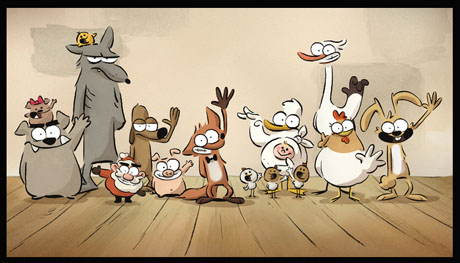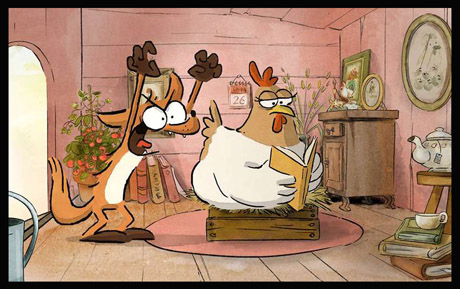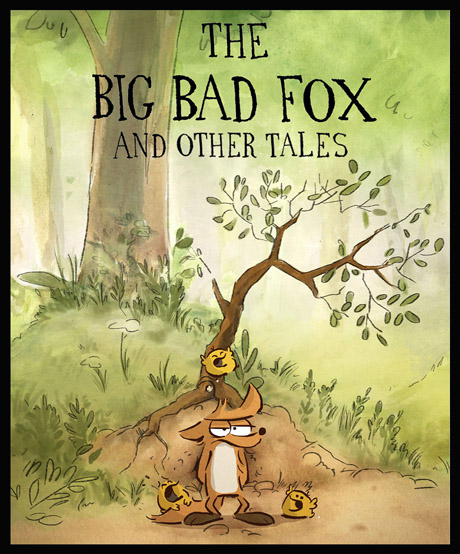
The Big Bad Fox & Other Tales is a hilarious Annie-nominated animated comedy based on popular French graphic novels. Directors Patrick Imbert and Benjamin Renner talk about creating this unique film.
Jackson Murphy: The three stories were originally going to be three separate TV specials. What made you guys decide to connect them into a feature film?
Patrick Imbert: Well, to be precise, we didn’t decide anything. One day, while we were working on the second special, our enthusiastic and beloved producer came in and said, “Hey guys, we have three separate stories, what about connecting them and make a long feature?!!” [And we said], mm… oh, well…are you sure?… connecting how?” And the producer said, “I don’t know, but I trust you. You’ll find something!”

Benjamin Renner: At first we were pretty annoyed by this situation. It didn’t feel very “professional” to make a feature film with 3 films that were not supposed to be together. We tried to find a link to connect the stories but the harder we tried, the more obvious it felt the feature was “artificial”. And that is how we came up the idea that the characters in the film were actually amateur actors who were performing on a very intimate theater scene. Their clumsiness is actually a reflection of us trying to make a professional feature. It was a way to embrace the weird situation instead of fighting it.
JM: Did you work on all three of them simultaneously or one at a time?
PI: We did the fox [story] first because it was the only one planned, then as the broadcaster loved the animatic and wanted some more, we did the baby, the Christmas and finally the theater scenes. Benjamin and I did the three storyboards before starting any animation and once it began there was no interruption between each special, just as a long feature process. The team stayed approximately the same all along the production.
JM: I love the framework of the theater atmosphere at the start and in between. How popular are local productions and dinner theater shows in France?
BR: I think it remains quite a popular thing. The “Théatre de Boulevard” is still popular in France and I think it still reaches any kind of audience. I know there are a lot of local productions for children in France. Actually Céline Ronté who took care of directing the voice actors on the film is also a director of children theater pieces. Talking and working with her certainly had an impact on the fact that we chose to set the film on a theater stage.
JM: Benjamin, what were some of the critical decisions you had to make in adapting your stories for the screen?
BR: I thought naively that it would be easy, that I would just take my drawings and it would miraculously make a proper storyboard… Well I was wrong. I could keep the structures of the stories but we had to recreate everything inside. I had to cut a lot of the dialogues, rewrite them, also add more visual gags that I couldn’t have in the comic. Also when I work with actors as a director, I have to change my characters depending on what the actors were going to offer. Of course they follow my directions but I’m never trying to force an actor to match exactly what I have in mind. I love to be surprised by what he is going to offer and that often leads to change parts of your characters in the film.

JM: What is it about hand-drawn animation that’s still so appealing to you guys as directors?
PI: First, we are drawers, everything comes from here. Making hand-drawn animation in our way is a very hand-crafted way. It’s simple, efficient, and much less complicated than CG process, the distance between the first idea and the final result is quite shorter and doesn’t require a heavy and technical process. As directors, we are able to take action in every step of the production, and we do many things by ourselves. Also, we enjoy to have a very small team. It’s like the “good old days”. Everything is under control and everybody feels affected.
JM: I laughed so much, especially during the “Baby Delivery” story with the pig, rabbit and duck. There’s a flavor reminiscent of the Looney Tunes, the Muppets and “Chicken Run” when it comes to the interactions of all these characters. What were your inspirations?
PI: We love all these shows. I would add the Chuck Jones ones and a big part of Miyazaki’s “lupin III” style. As director of the “Baby Delivery”, I can say that the main reference is not animation but the old slapstick movies by Charlie Chaplin and Buster Keaton. I love their visual humor, the rhythm and the choreography they use to make a shot. These words are generally used about music and I think we try to do visual music. We think in terms of choreography first, and the drawing details come later.
JM: The script often relies on facial expressions from these characters. Sometimes just the movements of eyeballs generates big laughs. How important are those kinds of details?
PI: We pay a lot a attention of the eyes movements. We can even modify its rhythm until the very end of the editing. Eyes tell so much of the character! Sometimes you don’t need to animate all of the character. It would be worse. And also, in a quiet shot, the look of the spectator is a focus on the character’s eyes, so it’s a useful tool.
JM: There’s a point in the third act where the pig, rabbit and duck are riding in their version of Santa’s sleigh and they slam into an old lady who’s walking out of the supermarket with her shopping cart. Would you agree “The Big Bad Fox and Other Tales” is pretty fearless overall?
PI: Well, I don’t know… maybe this scene is an unconscious revenge on the elderly who are so slow at the store checkout… 🙂
BR: I guess we just storyboard and write the film pretty instinctively. If something makes us laugh, we put it in the film, but if one of us or the producer says he or she is shocked, we don’t really insist and take the joke out. Even though the film feels fearless, I guess we always tried to be careful and respectful.

JM: There’s so much great dry humor for older kids and adults – and plenty of slapstick fun for kids. When you’ve screened the film for audiences – who seems to respond to it more: kids or adults?
PI: Both I think. When we create the jokes we don’t do it for any target (kids or adults), we just try to make it fun. Most of the time the kids understand the jokes for adults well, much more than what the people think generally. However, I noticed that the kids really laugh every time a character simply falls!
JM: You guys went through the Awards Season experience with “Ernest & Celestine” a few years ago. Benjamin, you went to the Oscars, and Patrick, you were nominated for an Annie. How did all of that prepare you for this Awards Season?
PI: To be honest, I don’t feel really concerned, this award stuff is far from me. Before “Ernest and Celestine” went there, I didn’t know its existence. Of course I would be happy to win something but considering the other movies, I don’t think it will happen.
BR: Honestly I think the film went much further that what we ever expected. But the awards season allowed us to visit the studios in LA and show the film to professional artists working in animation. I was so glad to share this work with them and also share the fact that animation is not always a long and laborious process. It can also be a light hearted experience. So I’m definitely not expecting much for this award season, but the simple fact that we could share our work was a fabulous experience.
JM: What do the Annie Nominations for “The Big Bad Fox” (Best Animated Feature – Independent and your noms for directing and character design) mean to you guys?
PI: The only thing I can say is that is really incredible that we started this project as a very humble TV special. It grew up little by little and now it’s there…. Funny!
BR: Symbolically it is a huge thing. One of the reasons we did the film was to prove the animation industry in Europe that you can produce a feature film with a reasonable budget (3 million dollars) in one single studio gathering directors, animators, background artists etc… Being nominated at the Annies is the kind of acknowledgement that we were not expecting but it is huge for what we tried to achieve.
JM: I can see this gang in a weekly TV series, or maybe an online series, that audiences around the world would love. Where will we see these characters next?
BR: Probably in other graphic novels. And I’m also working on a choose your own adventure online graphic novel with the same characters.
- INTERVIEW: “Inside Out 2” Director And Producer On Pixar Sequel - April 16, 2024
- INTERVIEW: “Puffin Rock And The New Friends” And 25 Years Of Cartoon Saloon - April 10, 2024
- INTERVIEW: “Chicken For Linda!” Directors On Annecy Winning Feature - April 9, 2024


 January 11th, 2018
January 11th, 2018  Jackson Murphy
Jackson Murphy  Posted in
Posted in  Tags:
Tags: 






